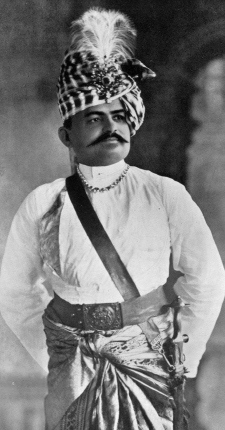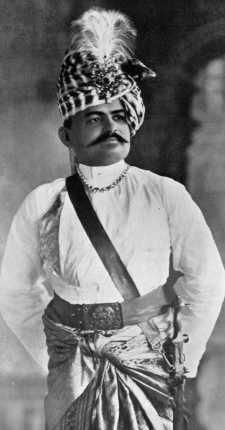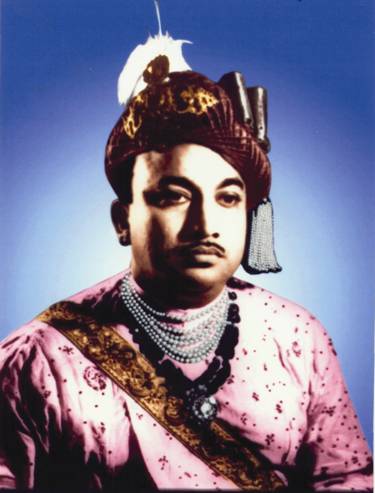
Raja of Ali Rajpur

Daulat Sinhji (Source: royalark.net)
Royalty in all forms is best described when we speak of Indian monarchs and their awe-inspiring tastes, whether it is regarding clothes, jewelry or how they chose to set their hair. Nothing escaped the richness in cultural exquisiteness when it came to the Rajas’, or in other words, the Kings that have since time served as a great reminder of Indian heritage and traditional values. Ali Rajpur is a monarchial province situated in the state of Madhya Pradesh. This was founded as early as 1437 by the Rathore dynasty of the Rajput clan. The royal clan of Ali Rajpur was given the prefix “Raja”.
Origin and History
Rajpur is the headquarters of this princely district and the reason for the name is a combination of the names of the capital and the word Ali, which means fortress town. This was a part of the Bopawar Agency until 1947. However, after Independence, this was merged with the Indian Union and it became a part of Madhya Pradesh in 1948.
The princely state of Ali Rajpur has a flag that is made up of 6 red and white bands which appear alternatively, where the red band appears at the top. These two colors represent an alliance of the Sovereign of Ali Rajpur and the Holkar Kingdom of Indore. Ali Rajpur was formed by Anand Deo who was a Rathore from the now ruling Jodhpur family. He had two great grandsons in Gugal Deo and Kesar Deo. Gugal went on to rule Ali Rajpur later whereas Kesar moved to another princely state. Ali Rajpur was lastly ruled by Surendra Singh which stopped in the 1980s. Monarchial rule was abolished in the late 1980s and hence, there was no particular role for any ruler after that time in Ali Rajpur.
Style
The Raja of Ali Rajpur is known for his exquisite taste for dress and the quality of fabric used for the dresses. The craftsmanship exhibited in the dresses was of high quality. The fabric and the material for the royal attire was brought in from various places from across the world. The turban was the highlight of the royal attire since it was of immense importance to differentiate the royal clan from the general public.
The pagda or the turban was of different varieties and the fabric of the turban worn by the royal men was of pure silk that was brought in from the silk center, Benares. The dhoti and the shirts had a lot of handwork embroidery on them and were of bright colors. The proximity to the Mughal Empire had inspired the Rajas to adopt a fondness for bright looking apparels.
The womenfolk were known for their exquisite sarees draped around their slender bodies and worn over their heads as a mark of tradition and respect. Most of the women in Ali Rajpur did not show their faces to men other than their husband or sons. The jewelry was of the highest quality stones and gems that went onto further showcase the prosperity of the Rajas.

Jaideep Sinhji (Source: iinet.net.au)
Influences over the years
The Raja dynasty of the Ali Rajpur province had undergone significant changes over the years. As the monarchial system got abolished, there were more avenues for youngsters to show case their talent and to go abroad for education. The male heirs were not required to take up the ruling powers and hence more focus was given to education and honing various skills to keep themselves abreast with the modern world. A lot of people migrated from Ali Rajpur to gain wider exposure in terms of better job opportunities. The old culture exists today only in the form of forts and temples and not in terms of the monarchial system.
There was a considerable progress in the development of women too. Women became more open and adapted themselves to the foreign environment. The people were getting used to lots of foreigners visiting their palaces and they started to change everything including their dress. Education was given utmost importance and hence the women became more empowered.
Global Influence
A lot of foreigners have started visiting Ali Rajpur for its cultural richness and for the architectural marvel of the temples they have. Also, Ali Rajpur is closely connected to metro cities like Mumbai and Delhi and people from here choose Ali Rajpur as a short holiday destination. The number of visitors has increased considerably over the years.
Several foreigners see Ali Rajpur as a culturally rich place that needs to be explored for the sheer architectural magnificence that it contains. Word of mouth advertising is the best thing to have happened to Ali Rajpur.
References
Categories: Fashion Cults, Royalty
